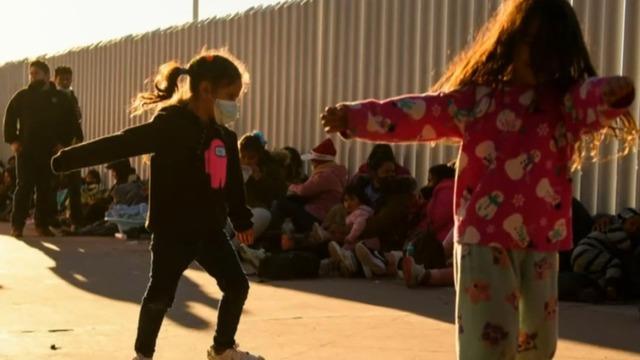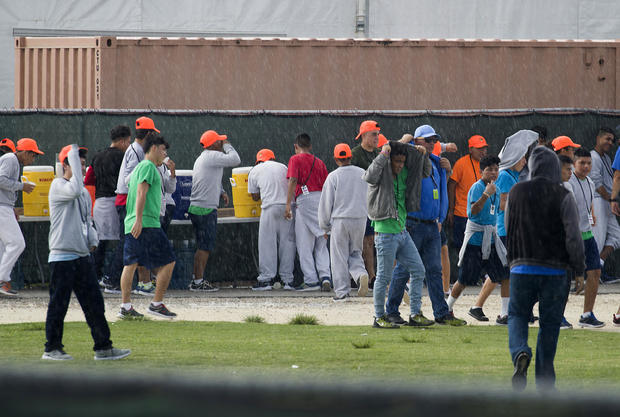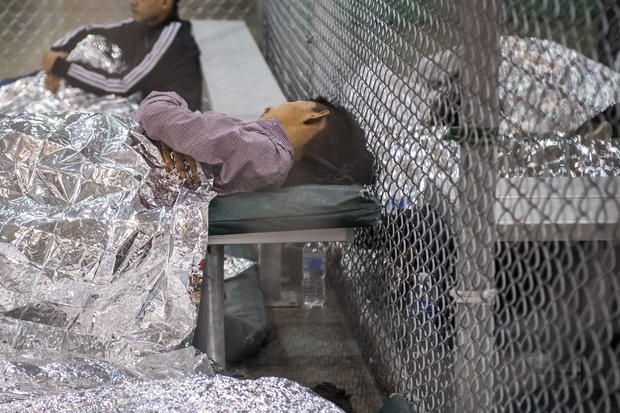▶ Watch Video: Shelters for migrant children near capacity along the border
The treatment of migrant children taken into custody along the U.S.-Mexico border has become a focal point of the national debate over immigration policy.
Over the past decade, Democratic and Republican administrations have struggled to adequately and safely process large numbers of unaccompanied minors, who have special legal protections under U.S law.
Since 2013, U.S. authorities along the southern border have taken into custody more than 445,000 unaccompanied children, including 72,000 in 2014 and 80,000 in 2019, according to Department of Homeland Security data.
The U.S. government has, for the most part, sought to discourage these children, many of whom come from areas in Central America plagued by poverty and violence, from journeying to the southern border, highlighting the often dangerous trek north.
Earlier this week, the Biden administration reopened an influx facility to house migrant teenagers in Texas in response to a marked uptick in interdictions of unaccompanied children that has severely strained the shelter bed space the U.S. government has for them.
The move sparked condemnation from critics with different political and policy views. Some suggested the U.S. government should not be in the business of holding minors in any facilities like the one opened in Texas. Others made accusations of hypocrisy, inaccurately equating influx holding facilities and state-licensed shelters with a border center featuring chain-link partitions resembling “cages.”
To provide clarity on the current situation, here’s an overview of the legal authorities and policies that govern the care of unaccompanied children, as well as the facilities where these minors are housed while in U.S. government custody.
What is the current legal process for unaccompanied children?
U.S. law defines unaccompanied migrant children as minors who don’t have legal permission to be in the country and who are taken into government custody without an accompanying parent or legal guardian.
The Homeland Security Act of 2002 charged the Office of Refugee Resettlement, a branch of the Department of Health and Human Services, with housing unaccompanied migrant children until they could be placed with vetted sponsors, who are typically family members residing in the U.S.
Another law, passed with bipartisan support in 2008, requires all government agencies to transfer most unaccompanied migrant children to the refugee office within 72 hours, absent extraordinary circumstances.
Unaccompanied children are typically first taken into custody along U.S. borders by Customs and Border Protection (CBP), a law enforcement agency whose facilities were largely designed to hold single adult men for short periods of time.
Internal CBP policy dictates that all migrants, especially unaccompanied minors, should be transferred out of the agency’s custody within 72 hours of apprehending them.
Once in the custody of the refugee office, migrant children have access to lawyers and, in some cases, child advocates. The agency is bound by law and a landmark federal court settlement to continuously pursue the release of these minors to sponsors who are willing to care for them.
The refugee office is allowed to release children to parents and legal guardians, as well as immediate relatives like siblings, grandparents, uncles, aunts and first cousins. In limited circumstances, children can also be placed with distant relatives or unrelated sponsors if no other caretakers are located. The agency requires all prospective sponsors to undergo background checks.
In some circumstances, the refugee office is unable to identify any sponsors for children. The agency can’t house minors once they reach legal age, which has, on some occasions, led to teenagers being transferred to Immigration and Customs Enforcement (ICE) detention centers for adults on their 18th birthdays.
Under the Flores Settlement Agreement of 1997, the U.S. government committed to house migrant children in the “least restrictive” settings possible and provide them basic necessities like water, food, toilets and medical care.
Do unaccompanied children have a legal right to stay in the U.S.?
Unlike migrant adults and families, U.S. law does not require unaccompanied children to seek asylum through an adversarial courtroom setting. Instead, they are allowed to undergo child-sensitive interviews with asylum officers. Unaccompanied minors are also shielded from expedited deportations.
In addition to asylum, unaccompanied minors can request visas for trafficking victims, as well as a protection known as Special Immigrant Juvenile Status that can place undocumented children who were abandoned, neglected or abused by one or both parents on a pathway to U.S. green card status.
If they lose their legal cases, unaccompanied children can be deported to their countries of birth. However, Department of Homeland Security data shows the vast majority have not been deported in recent years.
Are unaccompanied children held in “cages”?
Border Patrol oversees police-like stations with cinder-block cells that government officials and advocates agree are not adequate to hold children. Migrants have called these facilities “perreras,” or dog kennels, as well as “hieleras,” due to the cold temperatures experienced while sleeping on concrete floors.
During surges in border crossings in 2014 and 2019, these border stations became dangerously overcrowded, garnering national attention. Children were held for prolonged periods of time in cells with one toilet and border agents even used parking lots as makeshift detention areas.
CBP has also opened “soft-sided” tent complexes specifically designed to hold unaccompanied minors and families with children during upticks in border apprehensions. While migrants have more accommodations and space in these facilities, they are still secure structures designed for short-term custody.
In 2014, the Obama administration converted a warehouse in McAllen, Texas, into a detention facility and installed chain-link fencing to divide populations, like teenagers and families. Photos from the facility provoked a massive uproar in 2018 when the public became aware of the Trump administration’s policy of separating thousands of migrant families.
The notion of “kids in cages” gained traction and was subsequently used to criticize the Trump administration’s hard-line border and immigration policies, during and after the family separation crisis.
Where are unaccompanied minors housed after leaving Border Patrol custody?
The Office of Refugee Resettlement oversees shelters and foster homes that are licensed by states to house children.
Private nonprofits and for-profit groups operate more than 170 housing facilities in 22 states under grants from the refugee office. In limited circumstances, some youth are transferred to facilities that are more restrictive.
The refugee office offers unaccompanied youth in its custody food, educational services, access to legal counsel, recreational activities and medical services, including vaccination.
During influxes of border apprehensions, Republican and Democratic administrations have placed unaccompanied children in large temporary facilities. Unlike shelters, these facilities, used or built on federal property, have not been subject to state child welfare requirements.
The Obama administration used three Department of Defense installations to temporarily house unaccompanied children in 2014 and opened a temporary holding facility in Homestead, Florida, in 2016.
The Trump administration, meanwhile, opened two additional “influx” facilities in Texas in 2018 and 2019. Along with the Homestead facility, the facilities in Tornillo and Carrizo Springs — which were ultimately closed — came under withering criticism from advocates who objected to the housing conditions and the hiring of for-profit companies to run the installations.
On Monday, the Biden administration reopened the Carrizo Springs facility and is considering reopening the dormant Homestead facility to respond to the marked increase in apprehensions of unaccompanied minors along the southern border in recent days.
Children are not being held in cells at the Carrizo Springs facility, which does not have chain-link fencing.
While the refugee office oversees more than 13,000 beds for migrant children, it has said it can only use about 8,000 because of COVID-19 mitigation protocols. As of Monday, more than 7,100 of the available beds — or about 90% of them — were full.
Were unaccompanied children treated differently under Trump or Obama?
The Trump administration, and to some extent the Obama administration, argued that the legal safeguards Congress created for unaccompanied children encouraged teenagers and other minors from impoverished areas in Central America to enter the U.S. without authorization.
Both administrations urged Congress to change the law, which drew opposition from advocates.
Over four years, the Trump administration instituted several unprecedented policies to deter unaccompanied children from coming to the U.S. border, including a broad ban on asylum for non-Mexican minors and efforts to prosecute undocumented immigrants who sought to sponsor children in the refugee agency’s care.
During its “zero tolerance” crackdown, the Trump administration also incorrectly designated thousands of children it separated from their families as unaccompanied and sent them to shelters alone while their parents were prosecuted for crossing the border illegally.
In March 2020, the Trump administration invoked a public health authority dating back to the late 19th century to authorize border officials to expel migrants, including unaccompanied minors, without letting them apply for U.S. refuge. Thousands of unaccompanied children, including victims of gang and domestic violence, were expelled until a federal judge blocked the practice in November.
While an appeals court lifted that order late last month, the Biden administration has since announced it will exercise its discretion to not expel unaccompanied children. Instead, it will continue transferring them to the refugee office.
That policy choice, which White House press secretary Jen Psaki called a “human and moral objective,” could prove to be an early logistical and political test for the Biden administration. The alternative, Psaki said Wednesday, is off the table for now.
“We can send them back home,” Psaki said. “We’re not doing that.”




































